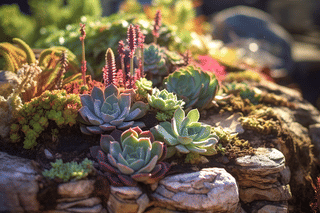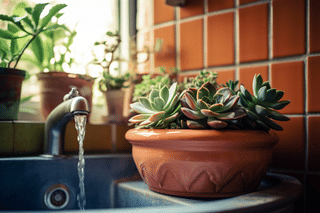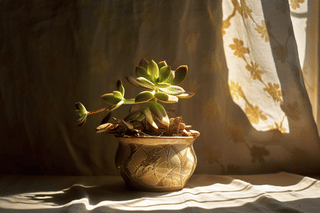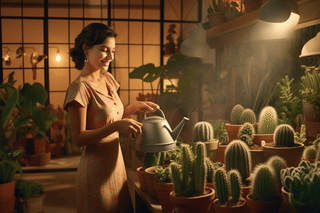How to water succulents: A beginner's guide
Learn how to properly water your succulents with this beginner's guide. These expert tips and easy-to-follow instructions will help your plants stay healthy and thriving. Say goodbye to soggy roots and hello to happy succulents!
Are you excited to learn about succulents? These small, colorful plants are very special. Not only can they brighten our homes, but they are also strong enough to fight the toughest of conditions. Even in places where many other plants cannot, succulents still thrive!
Although they seem like tough plants, succulents still need our help to flourish and grow to their full potential. The most important part of helping succulents is watering them correctly. They do not like too much water or too little water. If you are new to taking care of succulents and feel nervous about watering, this guide is for you!
In this easy guide for beginners, I will teach you how to water succulents. You will learn when your plant needs water, and when it has too much. These are the topics we're going to look at:
So, if you are taking care of a succulent for the first time or if you just want to learn more, this guide can help you. Watering succulents is an important job, and you can do it! Keep reading to learn how to help your succulents grow beautifully.
Understanding succulents and watering
Succulents are special plants that hold water inside their leaves, stems, or roots. This helps them live in dry places where there is not much water. Giving them too much water or too little can cause problems. Let's learn about the importance of giving your succulent the right amount of water to help it grow well.
The Importance of proper watering
Succulents are amazing plants that store water in their leaves, stems, or roots. This makes them incredibly resilient and capable of surviving in harsh, dry environments.
However, this unique skill also means they have different watering needs from other plants. Overwatering is a common mistake that can lead to root rot, a serious condition that can kill your plant. Underwatering, on the other hand, can leave your succulent thirsty and hinder its growth.
Luckily, once you know the watering requirements of one succulent, you can take care of almost all of them. So let's find out what the watering requirements of a typical succulent are!
Watering needs of a typical succulent
Each succulent is unique, but there is a common rule for watering most of them. Succulents do not need to be watered often, but when they are, they like a lot of water. Then, they want to dry out before getting water again.
Let's understand the watering needs of a typical succulent together.
How often should I water a succulent?
Succulents need the right balance of water to stay healthy and happy! How much water they need depends on the kind of succulent you have and their environment.
Generally speaking, give succulents a good watering once every 1-2 weeks in warmer months, but you can slow down a bit during cooler months when the plant isn't as active.
Just remember, it's always better to give them less water than too much, so don't worry if your succulent leaves start to look a little droopy. A little water when it's dry will revive the succulent as if nothing happened.
How much water should I use with a succulent?
When you're caring for your succulent plant, it's important to give them the right kind of water. Instead of sprinkling the soil with a little bit of moisture during every watering session, you should aim to do what's called "deep watering".
Deep watering means you soak the soil until it's full, like rain showers! It may sound counterintuitive at first, but this deep watering method mimics natural rainfall that succulents naturally adapt to in deserts and other dry environments. Doing this will make sure your succulent gets enough moisture so it can stay happy and healthy.
After watering the plant deeply, let the excess moisture drain from the drainage hole in the bottom of the pot for 5-10 minutes. The soil should now have absorbed the right amount of moisture and the excess moisture, the moisture that causes root rot, has drained away.
Recognizing overwatered vs underwatered succulents
Sometimes, it can be hard to tell if your succulent needs more water or less. But your plant will give you clues. By looking at its leaves and its growth, you can understand if it's getting the right amount of water.
Let's learn to listen to what your succulent is telling you about its water needs.
Signs of an overwatered Succulent
Overwatering is the most common cause of succulent death. Signs include:
- Leaves turning yellow or brown
- Swollen or mushy leaves
- Dropping leaves or petals
- A foul smell indicating root rot
If you see these signs, it's best to take immediate action. Remove the plant from its pot and check for root rot. If possible, trim any rotting roots and repot in a well-draining soil mix. Then, reduce the amount of water given and make sure to let the soil dry out completely before the next watering session.
Signs of an underwatered Succulent
On the other hand, your succulent may be underwatered if you notice:
- Leaves appearing shriveled or wrinkled
- Slow growth or leaves becoming smaller
- The plant turning a dull, faded color
If that's the case, give your succulent a good watering and make sure its soil is absorbing the moisture. Be sure to check for signs of overwatering after you water it.
Seasonal watering requirements for succulents
Believe it or not, succulents are just like all of us! They have different needs based on the season. That's why it pays to check in on your succulents' watering schedule every once in a while.
To make things super simple, here's how you can adjust their watering depending on the season so that they stay their happiest and healthiest:
Watering in the growing season (Spring and Summer)
During spring and summer, succulents are in their active growing season. This means they'll need more water to support their growth. Stick to the "once every 1-2 weeks" guideline during this period, but always check the soil's dryness before watering. If the soil is completely dry, it's time to water your succulent.
Watering in the dormant season (Fall and Winter)
In the cooler months of fall and winter, succulents enter a dormant or resting phase. They grow less and will need less water. During this time, you might only need to water your succulents once a month. Again, the soil's dryness is your best indicator if you need to water your plant. When in doubt, wait a few more days and check again.
Succulent watering techniques
Now that you know when it's best to water them, let's look at how to get it done. Here are some easy steps and tips that will help your succulents stay happy and healthy. The best part? No experience required! These watering techniques are beginner-friendly.
Water the soil, not the leaves
When it comes to watering your succulent, pour the water directly onto the soil itself. Aim to get the area around the plant soaked, not the plant itself. By avoiding splashing water onto the leaves of the succulent, you can prevent any potential fungal diseases.
The "Soak and Dry" method
Are you looking for the perfect way to water your succulent plant? Look no further than the "soak and dry" method! Here's how it works:
- Soak: Water your succulent's soil until it's completely drenched.
- Dry: Wait for the soil to dry out completely before watering again. This method mimics the rainfall patterns in a succulent's natural desert habitat. This natural rainfall pattern provides a good drink followed by a dry period, promoting healthy root growth.
Use a watering can with a long spout
A watering can with a long spout is ideal for succulents because it allows you to control the water flow and reach areas of the soil that might otherwise be difficult to get to without wetting the leaves. So if your succulent happens to live in a narrow, deep pot, then this type of watering can be very helpful!
Keep in mind that every single succulent is one of a kind, so each might need a little different care. Take some time each day or every other day and pay attention to how your plant is doing. This will help you to recognize any signs of trouble early on.
Importance of drainage for succulents
Succulents don't like wet feet for too long! That's why "drainage" or a system where water can leave the pot is so important for them.
By understanding key drainage rules, we can make sure your succulent always gets enough (yet not too much) water, so its roots stay happy and healthy.
Do succulents need a drainage hole?
When it comes to succulents, you'll want a pot with drainage holes. That way, water can easily run off the bottom of the pot and away from plant roots. If your pot doesn't already have a drainage hole, you can make your own by drilling in one.
Another solution is using the plastic pot your succulent came in. This pot, also called a nursery pot, has drainage holes. You can keep your plant in this pot and place the plant and the plastic pot inside your decorative pot without drainage holes. This way, you can still let the excess water drain and you don't have to drill holes or get new pots.
Extra tips for watering succulents
It doesn't stop at just watering if you want to take great care of your succulents! You should get to know the environment they are in and make sure that you choose the right soil for them. That extra attention does make a difference and can help promote the health of your succulent plant!
To ensure that you're giving your plants the proper care and nourishment, here's some more information I'd like to share with you.
Consider the environment
Watering your succulent is an important part of its care. Keeping an eye on things like humidity, sunlight, and temperature helps you to estimate how often you should water your succulent. For example, a dry and warm spot may mean that your succulent's soil dries up quicker than usual!
If you want to water your succulent more or less, you can move it to a cooler and darker area or a brighter and warmer area.
Choose the right soil
If you want to keep your succulents or cacti happy, give them the soil they love. Find a fast-draining mix designed just for them (cactus or succulent soil mix). This kind of soil helps prevent water from staying around the roots too long and can make all the difference to your plant's health and happiness!
Watch your succulent
Pay close attention to the condition of your succulent. Let its appearance be your guide as you make adjustments to best meet their needs. Are they looking a bit droopy? If so, they may need less water than expected. If wilted or brown, water it a little more often to help them be happy again.
Thank you for reading this post! I hope it helps you to keep your plants healthy and beautiful! If you're looking for more guides on specific plants, you can always request a plant guide to get a guide for the plant you have trouble with.
Test your plant care knowledge
Quiz completed!
Want to learn more? Sign up for my newsletter to receive free tips in your inbox!
Sign up now!



















